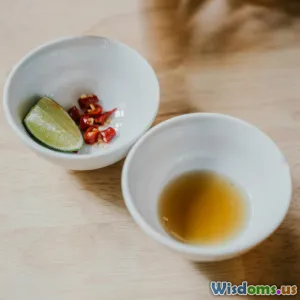
Elevate Your Dishes with Flavor Pairing
5 min read Discover the art of flavor pairing to transform your dishes into culinary masterpieces that delight the palate. (0 Reviews)
Elevate Your Dishes with Flavor Pairing
Cooking is not just about following recipes; it's an art form that allows for creativity and personal expression. One of the most powerful tools in a cook's arsenal is the concept of flavor pairing. Understanding how different flavors interact can elevate your dishes from ordinary to extraordinary. This article delves into the fascinating world of flavor pairing, providing you with insights and practical tips to enhance your culinary creations.
What is Flavor Pairing?
Flavor pairing refers to the practice of combining ingredients that complement and enhance each other’s flavors. It's guided by the principle that certain ingredients share flavor compounds, which can create a harmonious and balanced dish. For example, chocolate and coffee both have similar flavor compounds, which is why they work so well together.
The Science Behind Flavor Pairing
The science of flavor pairing is rooted in chemistry. According to research, flavors consist of various compounds that can interact in pleasing or unpleasing ways. For instance, the sweetness of strawberries can be beautifully contrasted with the acidity of balsamic vinegar, resulting in a delightful balance of flavors.
Essential Flavor Pairing Techniques
Here are some techniques to help you master flavor pairing:
1. Understand Flavor Profiles
Familiarize yourself with basic flavor profiles such as sweet, salty, sour, bitter, and umami. Each profile brings something unique to the table. For example, sweet flavors can round out and soften bitter or acidic elements, while umami can enhance the overall depth of a dish.
2. Use Flavor Wheels
Flavor wheels are visual tools that help you identify complementary flavors. They categorize flavors into primary groups and suggest pairings. For example, citrus fruits often pair well with herbs like basil or spices such as chili.
3. Experiment with Texture
Pairing flavors is not just about taste; it's also about texture. Combining creamy elements like avocado with crunchy ingredients like toasted nuts can create a satisfying mouthfeel alongside the flavors.
4. Think Regionally
Often, ingredients that grow together taste good together. For instance, Italian cuisine frequently combines tomatoes, basil, and mozzarella, while Thai dishes often feature coconut milk, lime, and lemongrass.
5. Utilize Contrasting Flavors
Don’t shy away from contrasting flavors. A sprinkle of salt can enhance sweetness, while a touch of acidity can brighten rich, fatty dishes. Experiment with combinations like sweet peaches with salty prosciutto or spicy chili with sweet mango.
Practical Flavor Pairing Examples
To put theory into practice, here are some delicious flavor pairing examples:
- Fruits and Cheese: Pair pears with blue cheese for a sophisticated appetizer.
- Herbs and Meats: Use rosemary with lamb or thyme with chicken for aromatic enhancement.
- Spices and Vegetables: Roast carrots with cumin or Brussels sprouts with nutmeg for a unique twist.
- Grains and Nuts: Combine quinoa with almonds and cranberries for a refreshing salad.
Conclusion
Elevating your dishes through flavor pairing is an exciting journey that invites experimentation and creativity. By understanding the science behind flavors and employing practical techniques, you can transform simple meals into culinary masterpieces. Whether you're a seasoned chef or a home cook, embracing the art of flavor pairing will not only enhance the taste of your dishes but also inspire you to explore new culinary horizons. So, don your apron, gather your ingredients, and start experimenting with flavors today!
Rate the Post
User Reviews
Popular Posts





















